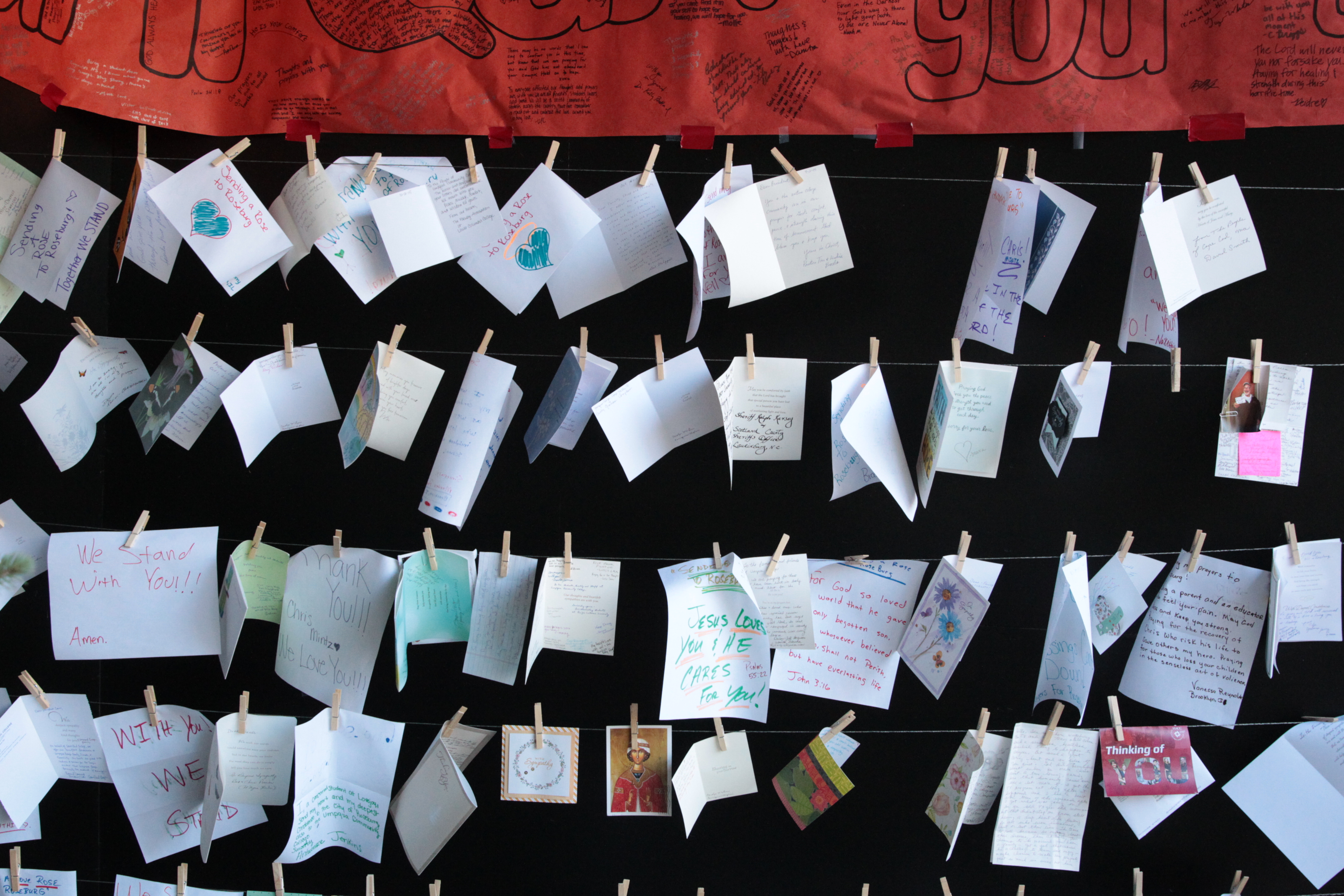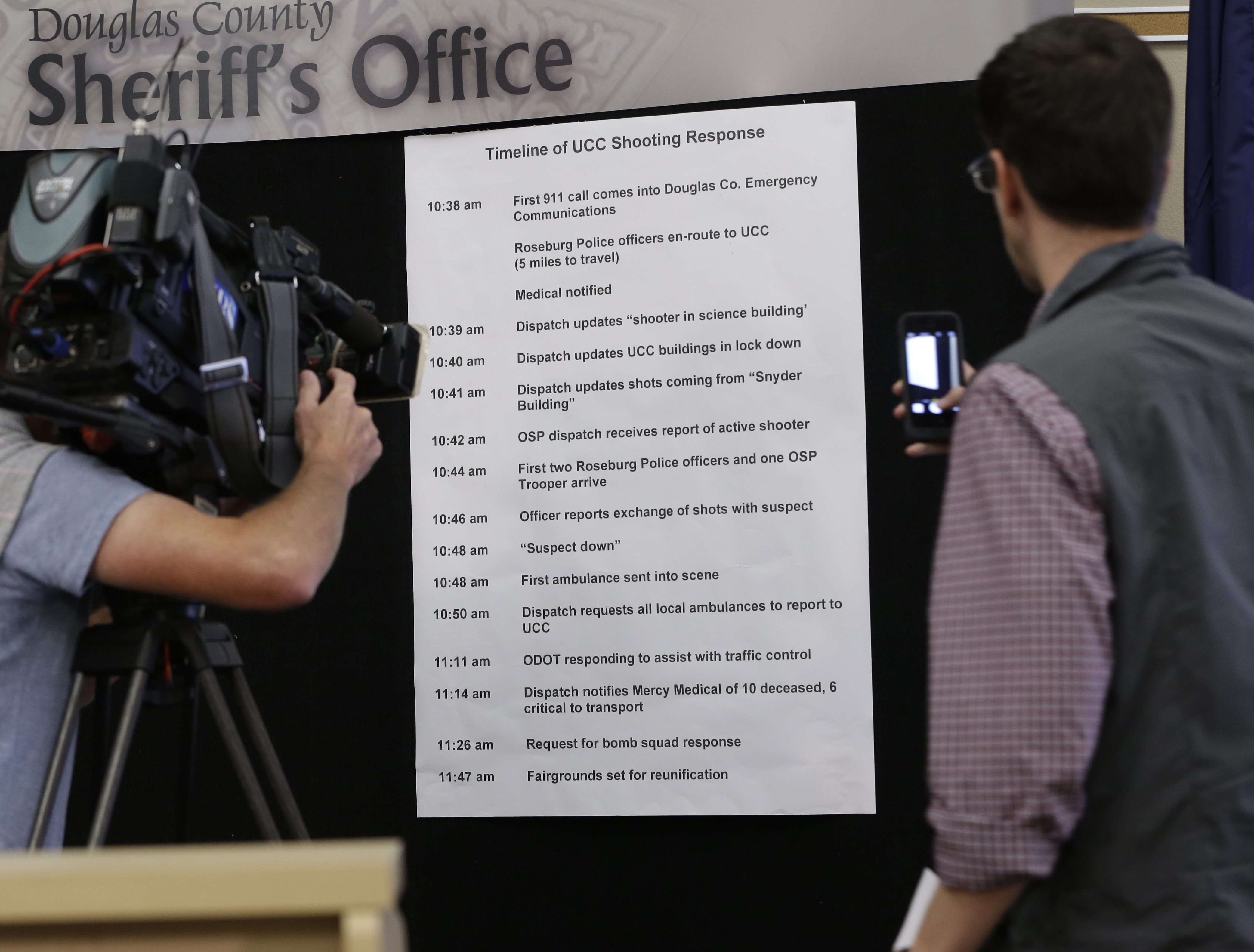Joseph Hoyt didn’t have class until 2 p.m. on the first day of October. So he was still in bed, scanning his phone, when he saw news that there was an active shooter at Umpqua Community College, just an hour away.
Then, he got an email from The Washington Post: Get there as soon as possible.
Hoyt, a senior at the University of Oregon’s School of Journalism and Communication, is part of the Post’s freelance Talent Network. He’s a sports reporter. That day, he was supposed to cover a high school game. Instead, he threw on some clothes, got into his car and headed south.
Hoyt wasn’t prepared to cover a mass shooting, or to knock on the front door of a household that lost someone that day. Maybe, he thinks now, you can’t ever prepare for that experience. But professors at the University of Oregon want Hoyt, his fellow students and other journalists to get the chance to try. Since the Umpqua Community College shooting, they’ve launched several projects to examine and understand how the media covers gun violence.
For the whole hour drive, which included a call to his mom, texts with editors at the Post, a call with Washington Post reporter Eli Saslow and a background of country music, Hoyt was in shock.
“Twenty minutes earlier, I’d been watching ‘Family Guy’ on Netflix in bed and reading Twitter.”
The process of discovering what journalists experienced while covering Roseburg has solidified one thing for the people behind the project: There were few processes in place, little to think through, as those reporters dropped everything and raced to the campus.
In the next year, they’re hoping to discover how shootings affect the communities involved, what impact they have on the journalists and how they can process these situations when there’s very little time to think.
‘Our responsibility’
When news of the shooting broke, Lori Shontz was with students on their way to an event about community engagement. Shontz, a journalism instructor, met up with Nicole Dahmen, an assistant professor, at the event.
Something clicked for both women then. Mass shootings continue to make news, but this one happened in their state, just about an hour south. They have graduates who now work for The News-Review in Roseburg. They have students who started at Umpqua Community College. They had students, including Hoyt, who were covering a story of this magnitude for the first time.
They needed to do something.
“We really saw this as our responsibility as journalism educators and media scholars to look at how gun violence and how mass shootings are being covered in the media,” Dahmen said.
Work on their project currently so far includes faculty appearances in the media, planned public forums, a collection of data visualizations and a pending documentary about the community’s healing process. There are studies on visuals from Roseburg and two other school shootings, a forthcoming multimedia project called “Reporting Roseburg,” and resources for journalism educators and professionals.
Last week, Shontz was awarded a fellowship from the University of Oregon’s Agora Journalism Center to expand the project into the community. She’s thinking of the next phase of the project as “Beyond Roseburg.” For it, she’ll compare Roseburg coverage with coverage of the 1998 Thurston shooting in Springfield, Oregon. What was it like for the people interviewed and photographed? How did it impact them?
The goal is to have curricula for coverage of mass shootings, with input from both journalists and the communities they cover, for both j-schools and professional newsrooms.
Early in her career, Shontz helped cover a mass shooting for the Pittsburgh Post-Gazette. She had no idea what she was doing.
Other colleagues who had previously covered shootings fell back on what they did before. And maybe that’s OK, she said. That’s how we learn.
“I think even the act of taking the time to think through a scenario before you find yourself in it makes a difference,” Shontz said “That’s why we teach ethics classes, right?”

Cards hang at Umpqua Community College, Monday, Oct. 12, 2015, in Roseburg, Oregon. (Beth Nakamura/The Oregonian via AP, Pool)
Beyond breaking
One thing Dahmen, Shontz, students and other faculty have learned so far: Journalists have to cover the breaking news, but they need to stick around after, too.
“We really see complex issues like gun shootings, mass violence need to go beyond who, what, when, where,” said Dahmen.
One analysis of Roseberg coverage yielded details that point to the short attention span of the media and a tendency to overemphasize the attacker. The day after the shooting, half of the newspaper front pages across the country collected by The Newseum included a photo from the shooting. By the third day, any visual coverage of Roseburg had nearly disappeared from those same front pages. During that period, there were 101 photos of the perpetrator on those front pages and 59 of the victims.
“Talk about coverage that emphasizes the perpetrator at the expense of the victim,” said Dahmen of the front pages examined.
The images she found followed a clear pattern, too: panic, then the perpetrator and victims and then nothing.
For the longer-term journalistic response, Dahmen emphasizes restorative narrative, a genre of journalism concerned with rehabilitation and renewal.
Restorative narrative emphasizes that recovery is a process, not something that happens overnight. This type of work is exemplified by stories such Saslow’s account of the life of a Roseburg survivor, Dahmen said.
“This doesn’t end for the victims after the breaking news ends,” she said. “This doesn’t end for the community after the breaking news ends.”

A timeline of law enforcement response to the Umpqua Community College shooting is posted for the media at a news conference, Saturday, Oct. 3, 2015, in Roseburg, Oregon. (AP Photo/Rich Pedroncelli)
‘What do I do? What do I say?’
In Roseburg, Hoyt had to rely on the instincts he’d begun developing as a young journalist and something Saslow told him on that ride to the campus: You can’t really prepare for some of the things you’re about to experience. But you can use your breaking news skills. And you can be a human.
Saslow has covered about five mass shootings so far, including reporting from Newtown, Connecticut, and San Bernardino, California. There is a kind of formula that comes from experience. Some of it comes from necessity: how many died, what are their names, what did they experience? But he also wants to do justice to the people whose lives have been changed or ended by the shooting. And to do that, the awfulness of what he’s covering can’t become routine.
“I need to be a little bit fucked up by the situation every time if I’m going to do a decent job,” Saslow said.
Hoyt was the first reporter in Roseburg for the Post. Saslow knew he’d never done anything like this before. You’re going to talk to the parents of people who died, he told him. You’re going to call people and try to get information. Those calls are awful when it’s just you.
“They’re borderline soul-shaking phone calls to make when you know that 10 other people from CNN and The New York Times and wherever else are racing to find those numbers, too, and make the call,” Saslow said. “My job is to give people an opportunity to talk if they want it, not to be pushy about it, not to think about it as a scoop.”
It’s not fair to write about someone’s life without giving them or the people around them the chance to talk, he said. And sometimes they want to. And sometimes you feel like a piranha in a feeding frenzy. If at the end of the day, you don’t feel conflicted and you don’t desperately need a beer, you’re in the wrong business, he said.
Saslow’s thoughts on covering mass shootings aren’t about scoops or routine. They’re about being prepared as a reporter so that when the unexpected happens, journalists can do their jobs. He recommends:
Practice reporting in person, face-to-face.
Think beyond the pattern the media reports these stories in.
Find the uniqueness in the community you’re covering.
And remember, he said, journalists don’t just do this work because someone pays them.
“This is what we do,” he said, “we go places and we try to tell their story.”
In October, Hoyt sat in his car for awhile outside the home of one family in Roseburg. He called Saslow.
“What do I do? What do I say?” Saslow remembered Hoyt asking.
“He made that call because he’s good at his job, not because he’s bad at it,” Saslow said. “You have to be human in those moments.”
Editor’s note: This story has been updated to clarify the difference between the front page study and the efforts of restorative narrative.







